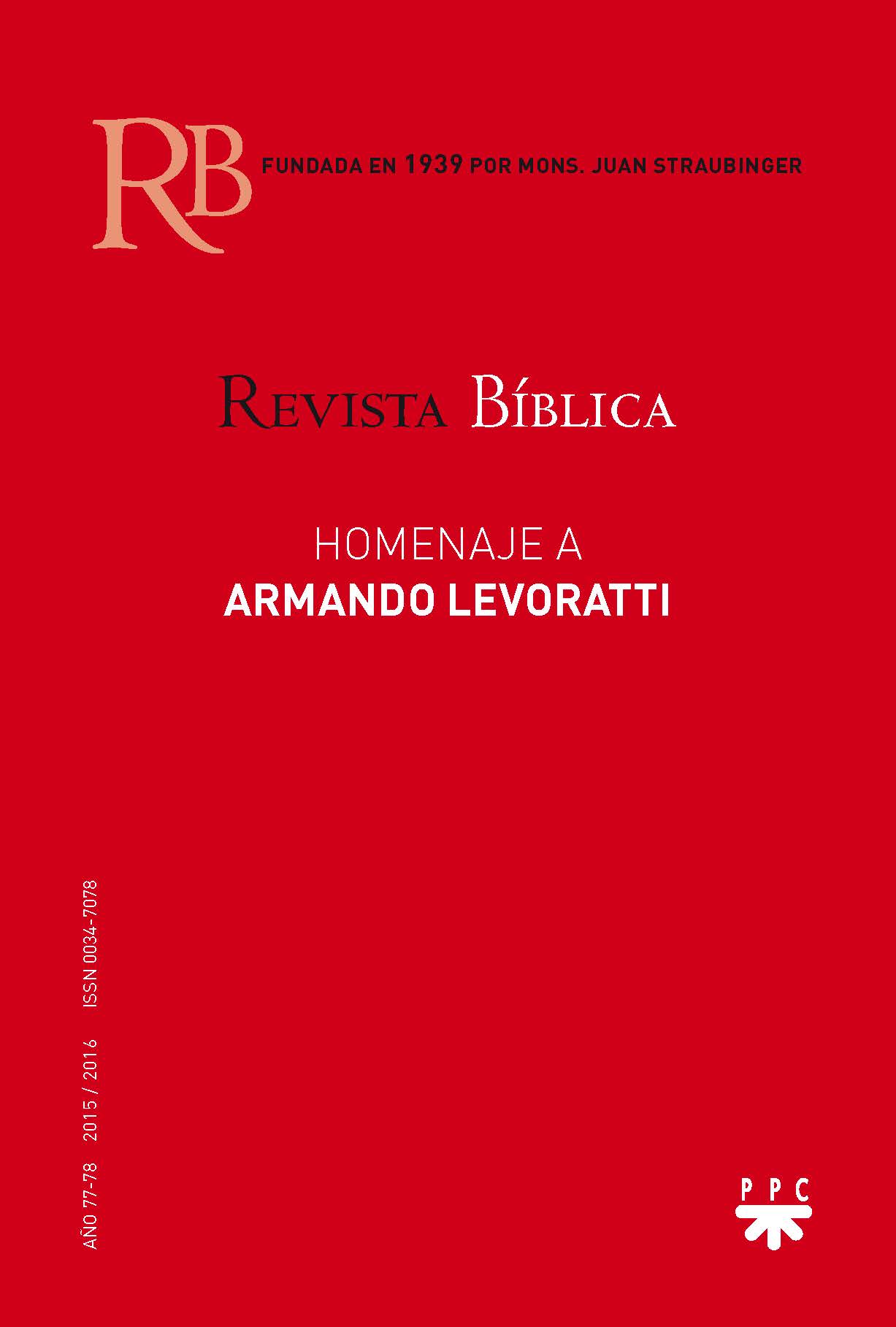Abandonos infantiles en la literatura cuneiforme y bíblica
DOI:
https://doi.org/10.47182/rb.77.n-201662Palabras clave:
Abandonos, Infancia, Mesopotamia, Biblia, Acadio, Sumerio, CuneiformeResumen
En el mundo de la mitología, los abandonos de niños fueron un tópico literario recurrente en prácticamente todas las civilizaciones antiguas. Sin embargo, el fenómeno de abandonar niños no debe circunscribirse solamente al plano mítico, ya que sin duda tal práctica se llevaría a cabo con relativa asiduidad. El objetivo de este artículo es presentar y analizar las principales fuentes que la literatura cuneiforme y bíblica (entre el III y el I milenio a. C.) ofrece para el estudio de las exposiciones infantiles. Con este propósito atenderemos a las principales características de los diferentes tipos de documentos, presentando, cuando sea conveniente, la traducción de ejemplos paradigmáticos para cada caso. La puesta en común de este corpus sobre abandonos infantiles en el Oriente antiguo ayudará a comprender mejor el mitema del niño expósito en las leyendas antiguas, así como el trágico trasfondo socio-económico por el que muchos padres optarían por abandonar sus hijos a su suerte.
Citas
Butz, K., 1980, “Landwirtschaft”, RlA 6, 470-486.
Cassin, E.-M., 1952, “Symboles de cession immobilière dans l’ancien droit mésopotamien”, L’Année Sociologique, 3e série, Paris, 107-161.
Cavigneaux, A., 1980/1983, “Lexikalische Listen”, RlA 6, 609-641.
Cogan, M., 1968, “A Technical Term for Exposure”, JNES 27 (1968) 133-135.
Colon, A. R. (con A. P. Colon), 2001, A History of Children: A Socio-cultural Survey Across Millennia, Westport.
Dandamaev, M. A., 2009, Slavery in Babylonia. From Nabopolassar to Alexander the Great (626-331 B. C.), Northern Illinois University (ed. rev. de la de 1984).
David, M., 1927, Die Adoption im altbabylonischen Recht, Leipzig.
Driver, G. R. – Miles, J. C., 1952, The Babylonian Laws, vol. I. Legal Commentary, Oxford. Durand, J.-M., 1987, “La population de Mari”, MARI 5, 664-665.
—, 2000, Les documents épistolaires du palais de Mari, LAPO 18, Paris.
Fleishman, J., 2005, “Continuity and Change in Some Provisions of the Code of Hammurabi’s Family Law”, en Sefati, Y. et al. 2005, “An experienced scribe who neglects nothing”. Ancient Near Eastern Studies in Honor of Jacob Klein, Bethseda, 480-496.
—, 2001, “Child Maintenance in the Laws of Eshnunna”, ZAR 7, 374-383.
—, 2009, “Did a Child’s Legal Status in Biblical Israel Depend upon his beign Acknowledged?”, Z AW 121, 350-368.
Franke, S. – Wilhelm, D., 1985, “Eine Mittelassyrische Fiktive Urkunde zur Wahrung des Anspruchs auf ein Findelkind”, Jahrbuch des Museums für Kunst und Gewerbe Hamburg 4, 19-26.
Garroway, K. H., 2014, Children in the Ancient Near Eastern Household (Explorations in Ancient Near Eastern Civilizations 3), Winona Lake.
Germain, L. F. R., 1975, “L’exposition des enfants nouveau-nés dans la Grèce ancienne: aspects sociologiques”, en L’enfant. Première partie: Antiquité – Afrique - Asie (Recueils de la Société Jean Bodin pour l’histoire comparative des institutions 35), Bruxelles, 211-246.
Gursky, M. D., 2001, Reproductive Rituals in Ancient Israel, New York.
Joannès, F., 1989, šêpê ina t.it.t.i šakânu,NABU 109, 81-82.
Justel, D., 2012a, “Adopciones infantiles en el Próximo Oriente Antiguo”, en id. (ed.), Niños en la Antigüedad. Estudios sobre la infancia en el Mediterráneo Antiguo, Zaragoza.
—, 2012b, “Some reflections on the age of adopted children and their adoptive parents at Nuzi”, SCCNH 20, Winona Lake, 141-157.
Klein, J. – Sharlach, T. M., 2007, “A Collection of Model Court Cases from Old Babylonian Nippur (CBS 11324)”, ZA 97, 1-25.
Klíma, J., 1975, “Le statut de l’enfant d’après les documents cunéiformes de Mari (Première moitié du 2e Millénaire avant J.C.)”, en L’enfant. Première partie: Antiquité – Afrique - Asie (Recueils de la Société Jean Bodin pour l’histoire comparative des institutions 35), Bruxelles, 119-130.
Kupper, J. R., 1954, Correspondance de Bahli-Lim, ARM 6, Paris.
Landsberger, B., 1937, Die Serie ana ittišu, Roma, 1937.
—, 1957, The Series AR-ra = ubullu, MSL 5 (tablillas I-IV), Roma.
—, 1958, The Series AR-ra = ubullu, MSL 6 (tablillas V-VII), Roma.
—, 1959, The Series AR-ra = ubullu, MSL 7 (tablillas VIII-XII), Roma.
Lara Peinado, F., 1982, Código de Hammurabi, Madrid.
Lewy, H. – Lewy, J., 1942-1943, “The origin of the week and the oldest west asiatic calendar”, HUCA 17, 1-152.
Malul, M., 1990, “Adoption of Foundlings in the Bible and Mesopotamian Documents. A Study of Some Legal Metaphores in Ezekiel 16.1-7”, JSOT 46, 97-126.
Meissner, B., 1982, “Studien zur serie ana ittišu”,ZA 7, 16-32.
Michel, C., 2001, “Listes lexicales”, en Joannès, F. (ed.), 2001, Dictionnaire de la Civilisation Mésopotamienne, París, 475-476.
Oppenheim, L., 1943, “Assyriological Gleanings I”, BASOR 91, 36-37.
Paul, S. M., 1979-1980, “Adoption Formulae: a study of cuneiform and biblical legal clauses”, MAARAV 2/2, 173-185.
San Nicolò, M., 1930, “Über Adoption und die Gerichtsbarkeit der mârbânî im neubabylonischen Rechte”, ZSS 50, 445-455.
Sancho Rocher, L., 2012, “??????????. Estrategias de natalidad en las ciudades griegas de época clásica”, en Justel 2012a, 163-198.
Sevilla Conde, A., 2012, “Morir ante suum diem. La infancia en Roma a través de la muerte”, en Justel 2012a, 199-233.
Stol, M., 2000, Birth in Babylonia and the Bible. Its Mediterranean Setting (CM 14), Groningen.
Swanepoel, M. G., 1993, “Ezekiel 16: Abandoned Child, Bride Adorned or Unfaithful Wife?”, 84-104, en Davies, Ph. R. – Clines, D. J. A. (eds.), Among the Prophets: Language, Image and Structure in the Prophetic Writings (JSOT Suppl. Series), Sheffield.
Szlechter, E., 1958, Tablettes juridiques de la 1re Dynastie de Babylone,2ème Partie, Paris. Wunsch, C., 2003-2004, “Findelkinder und Adoption nach neubabylonischen Quellen”, AfO 50, 174-244.
Yaron, R., 1965, “Varia on Adoption”, Journal of Juristic Papyrology 15, 171-183.
Publicado
Cómo citar
Número
Sección
Derechos de autor 2016 Revista Bíblica

Está obra está bajo licencia Creative Commons Attribution-NonCommercial-ShareAlike 4.0 International License.




